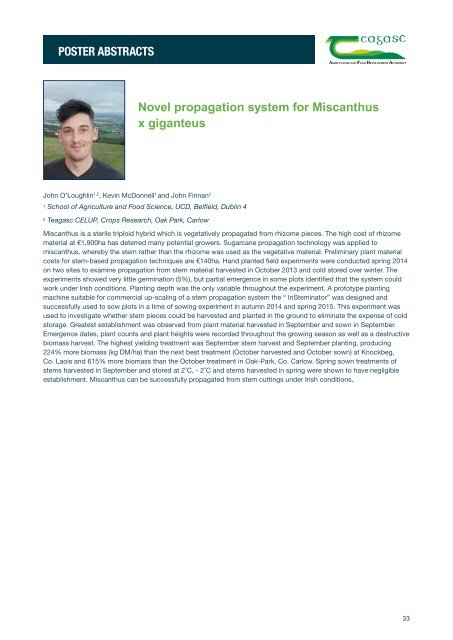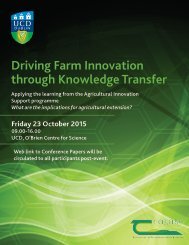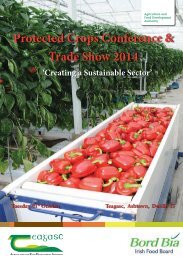FellowshipS Seminar 2016
2fFF9y9
2fFF9y9
You also want an ePaper? Increase the reach of your titles
YUMPU automatically turns print PDFs into web optimized ePapers that Google loves.
Poster ABSTRACTS<br />
Novel propagation system for Miscanthus<br />
x giganteus<br />
John O’Loughlin 1,2 , Kevin McDonnell 1 and John Finnan 2<br />
1 School of Agriculture and Food Science, UCD, Belfield, Dublin 4<br />
2 Teagasc CELUP, Crops Research, Oak Park, Carlow<br />
Miscanthus is a sterile triploid hybrid which is vegetatively propagated from rhizome pieces. The high cost of rhizome<br />
material at €1,900ha has deterred many potential growers. Sugarcane propagation technology was applied to<br />
miscanthus, whereby the stem rather than the rhizome was used as the vegetative material. Preliminary plant material<br />
costs for stem-based propagation techniques are €140ha. Hand planted field experiments were conducted spring 2014<br />
on two sites to examine propagation from stem material harvested in October 2013 and cold stored over winter. The<br />
experiments showed very little germination (5%), but partial emergence in some plots identified that the system could<br />
work under Irish conditions. Planting depth was the only variable throughout the experiment. A prototype planting<br />
machine suitable for commercial up-scaling of a stem propagation system the “ InSteminator” was designed and<br />
successfully used to sow plots in a time of sowing experiment in autumn 2014 and spring 2015. This experiment was<br />
used to investigate whether stem pieces could be harvested and planted in the ground to eliminate the expense of cold<br />
storage. Greatest establishment was observed from plant material harvested in September and sown in September.<br />
Emergence dates, plant counts and plant heights were recorded throughout the growing season as well as a destructive<br />
biomass harvest. The highest yielding treatment was September stem harvest and September planting, producing<br />
224% more biomass (kg DM/ha) than the next best treatment (October harvested and October sown) at Knockbeg,<br />
Co. Laois and 615% more biomass than the October treatment in Oak-Park, Co. Carlow. Spring sown treatments of<br />
stems harvested in September and stored at 2 ̊C, - 2 ̊C and stems harvested in spring were shown to have negligible<br />
establishment. Miscanthus can be successfully propagated from stem cuttings under Irish conditions.<br />
33




